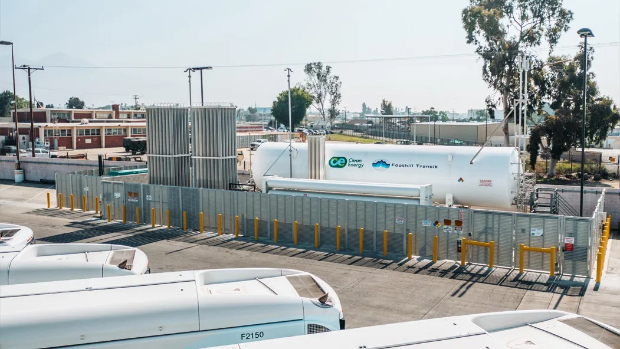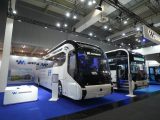
Hydrogen Fueling Station Boosts Foothill Transit’s Zero-Emission Bus Fleet
October 1, 2025Imagine rolling into the Arcadia bus yard at Foothill Transit on a crisp California morning. Instead of clouds of diesel exhaust, you’ll spot 19 brand-new fuel cell buses lined up and ready for a lightning-fast refill at the latest hydrogen fueling station. Clean Energy Fuels Corp. has won the bid to design, build, and maintain this shiny second station—an $11.3 million adventure funded by federal and state grants. In the heart of Los Angeles County’s endless sprawl—where nearly 9.84 million people live under that infamous smog—this project is turbocharging zero-emission transit in a big way, pushing Foothill Transit closer to its goal of a fully zero-emission fleet by 2040.
“We’re thrilled to deepen our 20-plus-year partnership with Foothill Transit,” says a spokesperson for Clean Energy Fuels Corp. “Over two decades, we’ve learned from early hydrogen trials and RNG rollouts—this station is the culmination of that experience. It keeps our buses rolling longer and cleaner, no compromises.”
Hydrogen fueling made simple
This station’s setup is slick: liquid hydrogen chills in vacuum-insulated tanks, then gets warmed into gas and pumped out through high-pressure nozzles built for fleet-scale speed. Safety’s taken seriously—think backup valves, leak sensors, and nonstop monitoring. The whole setup is built to exceed local and state safety codes, because you can never be too careful when dealing with cryogenic liquids in a busy yard. It runs 24/7, with remote data feeds that flag any hiccup so technicians can swoop in and fix issues before they cause downtime. Once the hydrogen hits the bus’s fuel cell stack, it teams up with oxygen to generate electricity, emitting nothing but water vapor. The best part? A refill is done in just 12–20 minutes—just like diesel—and each top-off sends drivers off with up to 400 miles of range, perfect for long regional loops.
Why hydrogen outpaces batteries
Battery electric buses have their highlight reel, but they often need hours to recharge and sometimes require costly grid upgrades. On the flip side, a hydrogen fueling station sidesteps heavy electrical hookups by getting hydrogen via pipeline or truck—making permits simpler and cutting down upfront costs. And since these stations are pretty modular, scaling up is as simple as adding another storage tank or pump—no costly grid overhaul required. Need a bus back on the road fast? The 12-minute fill is a game changer on tight schedules. Plus, in scorching LA afternoons or brisk mornings, hydrogen buses keep their cool (or heat), unlike batteries that can lose punch in extreme temps.
Arcadia: The new hydrogen hub
Sitting at the junction of busy freeways and dense suburbs, the Arcadia yard serves 38 routes in the San Gabriel and Pomona valleys and sees over 11 million passenger trips per year. Early collaboration with zoning and transit officials smoothed the permitting process and laid the groundwork for future expansion. And with local transit unions in the loop from day one, there were no nasty surprises. Draft plans already float for a third station down the road, proof this hub is only getting started. By adding a second hydrogen fueling station here, Foothill Transit ensures its cleanest buses avoid detours to distant pumps—keeping service zippy, reliable, and emissions-free.
Two decades of teamwork
Clean Energy Fuels Corp. has been pioneering clean fuels since 1997, running the continent’s largest renewable natural gas network and rapidly growing its hydrogen portfolio. Foothill Transit jumped on RNG buses in 2010 and flipped the switch on its first hydrogen station in Pomona back in 2021. Over these 20-plus years, they’ve shown that alternative fuels can meet brutal transit schedules and tough durability standards, setting a high bar for zero-emission transit.
Proven track record
The Pomona station—also built and run by Clean Energy Fuels Corp.—keeps 33 fuel cell buses moving with uptime north of 95%. Regular maintenance paired with remote diagnostics keeps everything humming around the clock, turning impressive reliability into fewer service delays and happier riders. It’s a clear signal that hydrogen infrastructure can handle the non-stop demands of public transit.
Real advantages for riders and the region
Switching to hydrogen fuel cell buses brings real, measurable perks:
- Zero tailpipe emissions: No NOx, particulate matter, or CO2 escaping into the air.
- Fast refueling: Diesel-like fill times keep buses in service, not in line.
- Extended range: Up to 400 miles per fill covers long suburban and highway routes without hitch.
- Quiet, smooth rides: Electric drivetrains that hush engine noise and reduce vibration.
- Cleaner air: Fewer pollutants helping millions breathe easier in LA’s smog-prone skies.
Economic boost and smart funding
At $11.3 million, this project leverages hefty federal and state grants—think Transit and Intercity Rail Capital Program funds—to keep local costs down. Construction and station operations mean new jobs for engineers, builders, and tech crews, and these investments trickle down into the community, from local hardware suppliers to nearby businesses that serve on-site workers. Plus, multi-year fuel and service contracts lock in predictable expenses for Foothill Transit.
Regulatory momentum
California’s Innovative Clean Transit rule mandates a switch to zero-emission buses by 2040, and programs like TIRCP and Clean Corridors grants pour money into cutting-edge projects. By tapping these incentives, Clean Energy Fuels Corp. and Foothill Transit turn regulatory requirements into real-world zero-emission transit infrastructure that’s ready to roll.
Scaling up for a cleaner future
With two hydrogen stations underway, Foothill Transit is building a backbone for a robust network and the rollout of dozens more fuel cell buses. Rumor has it they could grow their fleet to nearly 190 hydrogen buses down the road, with details still being whipped into shape. Each station makes the case for hydrogen’s starring role in public transit—and once green hydrogen supply chains catch up, these stations will be primed to switch over seamlessly, cutting any remaining carbon footprints.
As the Arcadia station fires up, the partnership between Clean Energy Fuels Corp. and Foothill Transit sends a clear signal: hydrogen isn’t just an option, it’s a key player in the future of cleaner, quieter, and more reliable transit in California—and beyond.



 With over 15 years of reporting hydrogen news, we are your premier source for the latest updates and insights in hydrogen and renewable energy.
With over 15 years of reporting hydrogen news, we are your premier source for the latest updates and insights in hydrogen and renewable energy.